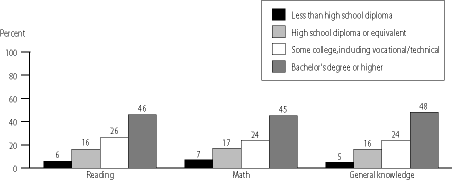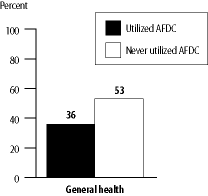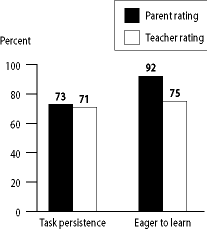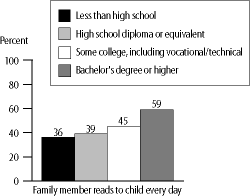This report presents the first findings from a new national study of kindergartners and their schools, classrooms, teachers, and families. The Early Childhood Longitudinal Study, Kindergarten Class of 1998-99 (ECLS-K), sponsored by the National Center for Education Statistics (NCES), began following a nationally representative sample of some 22,000 kindergartners in the fall of 1998.
ECLS-K will follow the same cohort of children from their entry into kindergarten through their fifth-grade year. Data will be collected not only in the fall of kindergarten but also in the spring of kindergarten, fall of first grade, spring of first grade, spring of third grade, and spring of fifth grade. In the fall of kindergarten, data were collected from children, their parents, and their teachers. Information from children was gathered during an individualized in-person assessment with the child in the child’s school, parents were interviewed over the phone, and teachers were given self-administered questionnaires.
In the fall of 1998, about 4 million children were attending kindergarten in the United States, approximately 95 percent of them for the first time. Of the children attending kindergarten, 85 percent were in public school, and 15 percent were in private school; 55 percent were in full-day programs, and 45 percent were in part-day programs.
This report is based on the 95 percent of children entering kindergarten for the first time in the fall of 1998. Future reports will provide information on those children who repeated kindergarten in the fall of 1998.
Cognitive skills and knowledge
Children’s cognitive skills and knowledge are frequently thought of as core ingredients in the recipe for success in school. Researchers have conceived cognitive develop- ment as an extended set of multidimensional skills and proficiencies that include language/literacy, reasoning, and general knowledge (Kagan, Moore, and Bredekamp 1995). Children’s language/literacy refers to both their oral communication (language) and understanding of the written word (literacy). Children’s reasoning refers to their mathematical skills. The concept of general knowledge refers to children’s conceptions and understandings of the world around them.
As children enter kindergarten for the first time, they differ in their cognitive skills and knowledge. The ECLS-K assessments of first-time kindergartners indicate that children’s reading, mathematics, and general knowledge are related to their age as they enter kindergarten, the level of their mother’s education (figure A), their family type, the primary language spoken in the home, and their race/ethnicity.
- In reading, mathematics, and general knowledge, older kindergartners (born in 1992-about to turn 6 or already 6) outperform the youngest kindergartners (born in September through December 1993-just turning 5).
The older kindergartners are more likely to score in the highest quartile of the distribution of scores than the youngest kindergartners. However, some of the youngest children also score in the highest quartile (16 percent in reading, 12 percent in mathematics, and 12 percent in general knowledge). Additionally, some of the older kindergartners are scoring in the lowest quartile (15-19 percent in reading, 13-17 percent in mathematics, and 11-16 percent in general knowledge).
- Children’s performance in reading, mathematics, and general knowledge increases with the level of their mothers’ education.
Kindergartners whose mothers have more education are more likely to score in the highest quartile in reading, mathematics, and general knowledge than all other kindergartners. However, some children whose mothers have less than a high school education also score in the highest quartile (6 percent in reading, 7 percent in mathematics, and 5 percent in general knowledge). Additionally, some children whose mothers have a bachelor’s degree or higher are scoring in the lowest quartile (8 percent in reading, 18 percent in mathematics, and 10 percent in general knowledge).
- Children’s performance in reading, mathematics, and general knowledge differs by their family type.
Kindergartners from two-parent families are more likely to score in the highest quartile in reading, mathematics, and general knowledge than children from single-mother families. However, some children with single mothers also score in the highest quartile (14 percent in reading, 14 percent in mathematics, and 12 percent in general knowledge). Additionally, some children from two-parent families are scoring in the lowest quartile (22 percent in reading, 21 percent in mathematics, and 20 percent in general knowledge).
In terms of their specific skills in reading and math, 66 percent of first-time kindergartners are proficient in recognizing their letters, 29 percent are proficient in understanding the beginning sounds (letter-sound relationship at the beginning of words), and about 17 percent are proficient in understanding the ending sounds (letter-sound relationship at the end of words). In math, nearly all first-time kindergartners (94 percent) are proficient in number and shape (recognizing numbers and shapes and counting to 10), 58 percent are proficient in understanding relative size (sequencing patterns and using nonstandard units of length to compare objects), and 20 percent are proficient in understanding ordinal sequence (identification of the ordinal position of an object in a sequence-e.g., fifth in line).
Figure A. Percentage of first-time kindergartners scoring in the highest quartile of reading, math, and general knowledge, by maternal education: Fall 1998

Source: U.S. Department of Education, National Center for Education Statistics, Early Childhood Longitudinal Study, Kindergarten Class of 1998-99 (ECLS-K), Fall 1998.
Social skills
Children’s social skills relate both to the quality and success of their school experiences (Meisels, Atkins-Burnett, and Nicholson 1996). Young children construct knowledge by interacting with others and their environment (Bandura 1986). In order to interact successfully in a variety of circumstances and with a variety of people, children need to possess interpersonal skills. They need to feel secure enough to join, question, and listen to their peers and adults. This report explores indicators of children’s social development by looking at children’s interpersonal skills and behavioral patterns as rated by their parents and teachers.
For the most part, parents and teachers report a high incidence of prosocial behaviors and a low incidence of problem behaviors. Parents report that about 82 to 89 percent of first-time kindergartners often to very often join others in play, make friends, and comfort others. Teachers report that about 75 percent of first-time kindergartners often to very often accept peer ideas and form friendships. In terms of more problematic behaviors (e.g., fighting and arguing), parents report that about 33 percent of first-time kindergartners argue with others often to very often and less than 20 percent of first-time kindergartners fight with others and easily get angry often to very often. Teacher ratings are lower, with about 10 percent of first-time kindergartners arguing with others, fighting with others, and easily getting angry often to very often. Teacher ratings of children’s prosocial and problem behaviors differ by children’s family type and minority status.
- Kindergarten teachers rate children with some characteristics of risk for school difficulty (those whose mothers have less than a high school education, whose mothers are single, or whose families have received or are receiving public assistance) as less likely than children whose mothers have at least a high school diploma, who come from two-parent families, and whose families have never utilized public assistance to accept peer ideas and form friendships.
- Reports of children’s problem behaviors vary by race/ethnicity.
The pattern of these differences and their magnitude depends on who is rating the children’s behavior. When teachers rate the children in their classrooms, black children are more likely than white and Asian children to be seen as exhibiting higher levels of problem behaviors (arguing with others, fighting with others, getting angry easily). When parents rate their children, we see fewer differences between black and white children. Instead, we see more differences between Asian children and white, black, and Hispanic children. Asian children are less likely than children in these other groups to be seen as arguing or fighting often to very often by their parents.
Physical health and well-being
Information on children’s physicality helps untangle the diverse skill set children possess at entry into kindergarten. An important part of learning relates to children having enough rest, enough good foods to eat, and good physical health (Kagan, Moore, and Bredekamp 1995). The concept of physical health and well-being is broad; it not only includes a disease-free state but also having gross and fine motor skills appropriate to the child’s age.
On average, first-time kindergartners are about 45 inches tall and weigh about 46 pounds. About 12 percent of boys and 11 percent of girls have a body mass index that classifies them as at risk for being overweight. According to parent reports, kindergartners are generally healthy, though their general health differs by their family type, the level of their mothers’ education, and whether or not they utilized public assistance (i.e., Aid to Families with Dependent Children) (figure B). A small percentage of kindergartners are showing signs of developmental difficulty (e.g., high activity level, low attention span).
Figure B. Percentage of first-time kindergartners who are in excellent general health, by utilization of public assistance (Aid to Families with Dependent Children [AFDC]): Fall 1998

Source: U.S. Department of Education, National Center for Education Statistics, Early Childhood Longitudinal Study, Kindergarten Class of 1998-99 (ECLS-K), Fall 1998.
Approaches to learning
How children approach learning is central to their chances for success in school. Children’s learning styles reflect how they address the task of learning (Kagan, Moore, and Bredekamp 1995). Children need to be able to persist at tasks, be eager to learn, and be creative in their work. These characteristics tend to manifest themselves at a relatively early age, and children demonstrate diversity in their approaches and behaviors toward learning.
As children enter kindergarten for the first time, parents report that about 73 percent persist at tasks often to very often (figure C), about 92 percent seem eager to learn (figure C), and 85 percent demonstrate creativity in their work. Teachers are slightly more conservative in their ratings (figure C), reporting that about two-thirds to three-quarters of beginning kindergartners often to very often persist at tasks, seem eager to learn, and are able to pay attention. Teacher ratings of kindergartners’ approaches to learning differ by child characteristics, such as gender, age at entry, level of mother’s education, and minority status.
Both parents and teachers report that girls persist at tasks more often than boys, older kindergartners (born in 1992) persist at tasks more often than the youngest kindergartners (born in September through December 1993), and children not at risk persist at tasks more often than children with certain risk factors (mother’s education is less than high school, mother is single, or family has received public assistance).
Figure C. Percentage of first-time kindergartners rated as persisting at tasks and eager to learn often to very often, by parent and teacher report: Fall 1998

Source: U.S. Department of Education, National Center for Education Statistics, Early Childhood Longitudinal Study, Kindergarten Class of 1998-99 (ECLS-K), Fall 1998.
The child and the family
The nature and frequency of family interactions relate not only to children’s development but also to children’s preparedness for school. The frequency with which parents interact in positive ways with their children may indicate the investment parents make in their children’s education. Home activities-such as reading to the child or interacting through play-are related to children’s school preparedness and chances for success in school.
The majority of parents report having more than 25 children’s books in the home, and more than half of parents report having more than five children’s records, audiotapes, or CDs in the home. Nearly half of parents report a family member reading to the child or singing songs with the child every day. Activities such as reading to children vary by level of mother’s education (figure D), family type, receipt of public assistance, and minority status.
As the labor force participation rate of mothers with young children has increased, the percentage of children receiving care from someone other than their parents has increased as well. In the 1990s, a large majority of children have been cared for on a regular basis by someone other than their parents prior to entering first grade (West, Wright, and Germino-Hausken 1993). Today, many kindergarten and primary school children receive before- and after-school care regularly from persons other than their parents (Brimhall, Reaney, and West 1999).
Prior to starting kindergarten, about four out of five first-time kindergartners received care on a regular basis from someone other than their parents. Upon entering kindergarten, about half of children currently receive care on a regular basis before or after school from someone other than their parents. Both the care children received prior to kindergarten and their current care (e.g., relative, nonrelative, center-based) vary by characteristics such as level of mother’s education and child’s race/ethnicity status.
At kindergarten entry, children whose mothers have less than a high school education are more likely to receive before- and/or after-school care from a relative than from a nonrelative or center-based provider. In contrast, kindergartners whose mothers have a college education are more likely to receive care in a center-based setting than in either of the two home-based settings. At kindergarten entry, black children are more likely than white, Asian, or Hispanic children to receive before- and/or after-school care.
Figure D. Percentage of first-time kindergartners read to every day by a family member, by maternal education: Fall 1998

Source: U.S. Department of Education, National Center for Education Statistics, Early Childhood Longitudinal Study, Kindergarten Class of 1998-99 (ECLS-K), Fall 1998.
Summary
While first-time kindergartners are similar in many ways, this report demonstrates that differences exist in children’s skills and knowledge in relation to their characteristics, background, and experiences. The report adds to our understanding of the diversity of young children’s skills and knowledge.
Even as they are just beginning their formalized educational experience, children are different. They demonstrate differences in their cognitive skills and knowledge, social skills, health, and approaches to learning, and bring with them differences in their home educational experiences and environments. This report is highly descriptive in nature, presenting a broad array of information on children’s status as they begin their journey through school.
Future reports based on ECLS-K will take a more analytical approach and examine specific issues in more depth. This report and future data from ECLS-K will help to inform researchers, practitioners, educators, parents, and policymakers on issues concerning young children’s education during the elementary grades.
